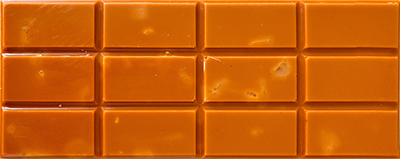When I first read about J Street Chocolate’s bean-to-bars with fermented and food byproduct inclusions in an SF Eater article earlier this year, I was intrigued. But so were a lot of other people resulting in a sold out shop on the website when I clicked through the article 😞.
I signed up for their newsletter to get notices of site restocking, new bars, and popups. And I was rewarded this summer when I got an announcement about upcoming J Street Chocolate popups in the East Bay where not only could I sample and buy chocolate but meet the maker too. Score!
I admit that I get excited about chocolate easily, but I was extra excited by the uniqueness of J Street’s inclusions: ingredients like spent grain from beer making, castoffs from saki manufacturing, excess sourdough bread from local bakeries, and fermented chili paste. Chocolate is fermented, so fermented inclusions work well in general (although the kimchi chocolate I tried was ugh). I hadn’t heard of a lot of J Street’s inclusions before so my curiosity was piqued. Plus I like the idea of reducing food waste, especially if it can be done on a larger scale than just me eating leftovers.
So on a Saturday morning, Cacaopod and I stopped by Oaktown Spice Shop on Solano to get the scoop on J Street Chocolate’s chocolates. When we got there, the staff was gathered around Julia Street, J Street’s founder and chocolate maker, as she explained the chocolate and handed out samples. Our favorite kind of meetup.
72% Camino Verde Moromi
The first sample we tried was the 72% Camino Verde Moromi. Camino Verde (Ecuador) is where the beans were sourced, but moromi was a new word to me.
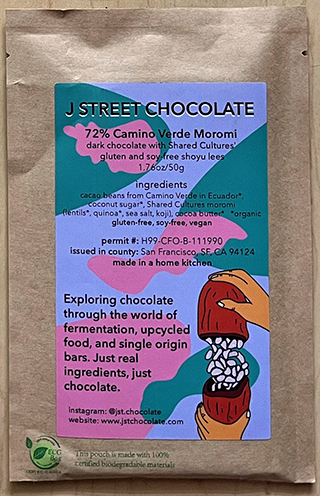
Julia explained that moromi is typically the solids left over from pressing soy sauce. Soy sauce is usually made from wheat and rice koji, which is the fermentation agent like sourdough starter. The moromi (AKA shoyu lees) J Street uses in this bar is a little different in that it’s made with lentils and quinoa instead of wheat so it can be gluten and soy free. Like a lot of the upcycled food “waste” she uses, Julia dehydrated the moromi, then added it to the chocolate both ground up and in bigger bits that made for a varied taste experience.
So what does it taste like?
Initially it was a fruit forward taste and not very sweet. As it melted I encountered some very small crunchy bits that added a little saltiness. The crunchy chocolatey salty bits won me over. I also got a bar and noticed that the salty crunchy bits are unevenly distributed in the bar. Bites without the crunchy bits had a dusty bitter overtone. Not bad but pieces with the salty bits were addictive. More salty bits please!
I was sold on that first sample and had to try all the rest of the flavors available. Available is a key concept here. Because J Street Chocolate uses food processing byproducts, not all bars are available at all times. Similar to working with seasonal ingredients but maybe for more unique reasons. For example, the Sourdough Crunch bar which includes dried bread crumbs wasn’t available at the popups or online because the bakery Julia sources the bread from was temporarily closed because they are moving.
Luckily, there were plenty of other flavors to try. And Julia is always thinking of new inclusions, experimenting, and adding new flavors.
70% Olive the Thyme
The 70% Olive the Thyme added a fun name to the J Street vibe. Like all of the bars, it was well made with a good snap and smooth texture. The fermentation in this bar was the cured olives, which she did herself. Props.
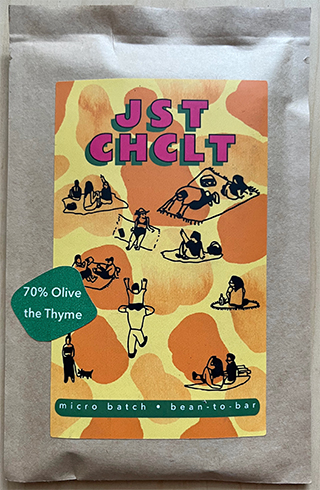
In addition to the black olives and thyme, the bar contained toasted almonds. The olive pieces and almond bits were visible on the bar and it smelled like olive. It also used what is becoming my fav single origin cacao: Kokoa Kamili from Tanzania, which I think is an appropriate choice for J Street Chocolate because it’s a very fermented, fruity tasting chocolate.
That fruitiness also made for a good combo with the olives. While the initial taste was almond, it became distinctly black olive but never overbearingly so. The tiny crunch from almonds was nice and it ended with a little salt. A mild olive aftertaste lingered.
I didn’t taste the thyme the first time but I did in second piece. Maybe it depends on having the herb in the piece because the second piece had a little thyme leaf at end. It was nice, not straight thyme but citrusy. (Reading the ingredients I see it was lemon thyme.)
It was an impressive bar. Cured olives and chocolate seems like it would be a tough combo, and while this was a savory bar (as are most J Street bars), the fruitiness of the Kokoa Kamili cacao balanced the savory elements.
55% Caramelized Koji Mylk
All J Street Chocolate bars are vegan, including the “milk chocolate” one we tried. The 55% Caramelized Koji Mylk Chocolate uses the same Tanzanian beans as Olive the Thyme, but has a simpler ingredients list similar to the 72% Camino Verde Moromi: organic cacao, cocoa butter, and cane sugar, and instead of moromi, caramelized rice koji.
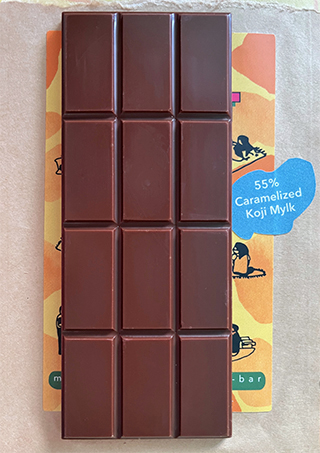
No milk or the usual milk alternatives in this one. The koji is what gives it a sweeter profile. Julia explained that you can make koji more sweet by slowly caramelizing it, and it’s used in amazake, a Japanese fermented but low/non-alcoholic rice drink to make it sweet.
The caramelized rice koji gave the chocolate an interesting slightly starchy texture. The bar had a good snap and a savory scent. It had the familiar Kokoa Kamili fruity chocolate taste but this time it was also nutty tasting. It was not as sweet as the cacao percentage led me to expect (Julia explained that it is about 20% sugar and the rest of the sweetness comes from the koji).
The texture reminded me of mochi — the bar wasn’t chewy like mochi, but it had a silky glutinous texture as it melted. The taste also developed into a smoky caramelized flavor. Definitely a chocolate to let melt slowly on your tongue to get the slightly starchy texture and all the flavors.
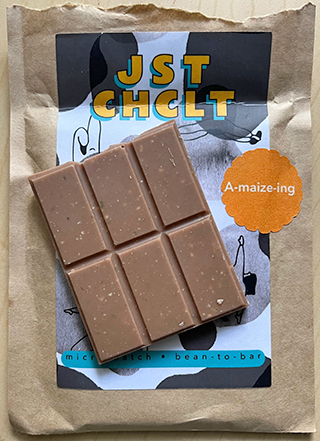
A-maize-ing
The A-maize-ing bar was another one with a starchy texture. The texture was more pronounced than the Koji Mylk bar, and the bar’s name is accurate: the texture comes from corn (maize) and it tastes amazing.
It’s a savory white chocolate bar and uses a masa harina miso for flavor and that starchy texture. Miso is traditionally fermented soybeans, but Julia started in fermentation before getting into chocolate 4 years ago, so I’m thinking she can ferment just about anything. This time it’s heirloom corn.
The bar was a grayish light brown with yellow specks from dehydrated corn miso added for crunch. It had a good snap for a white chocolate and was so interesting with the starchy texture and crunchy bits. It tasted a little roasted and salty at first, then the rosemary came in and lingered.
If you want to try a savory white chocolate, I recommend this one. But don’t expect it to taste like chocolate. White chocolate never tastes like real chocolate to me, and this bar moves farther away from its chocolate roots with its savory flavors.
Twist & Stout
While it’s not currently available — Julia said her supply of this popular bar depends on when she can get more stout from the brewery — we did get to sample the 69% Twist & Stout, which is probably the most mainstream flavored bar she makes. A little more exotic than chocolate infused with wine or liqueurs, but chances are if you are adventurous at all in your chocolate tastings, you’ve had a beer/stout infused chocolate.
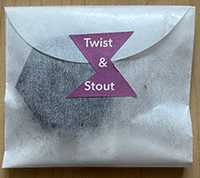
Like all J Street chocolate, this was well made and delicious. Made with Camino Verde cacao, but it was a fruity chocolate with a little banana candy flavor overtone. Julia said it was made with Laughing Monk Brewing’s Father Crilly stout, which she was helping them finish a keg so they could switch out to more summery beers. Nothing buzzy or beer tasting. It had a nice crunch from caramelized nibs and a slight drying after-sensation. I liked it, I can see why it’s popular.
72% Some Like It Mild
The last flavored chocolate we tried at this popup was the 72% Some Like It Mild. A mild fermented chili paste was added to the fruity fermented Kokoa Kamili cacao in this bar and it took a little time melting before I got any heat. It got hotter as it melted, but it was never very hot. The chili paste made from Aleppo and El Eden peppers seemed to accent the bean’s fruitiness more than be about heat. Another smooth, not too sweet bar with a little salt at end.
Another result of the mild peppers used was that I could taste the chili pepper flavor at the end. I really liked that, so often I just get the hot sensation from added peppers; this time I could taste their flavor too.
Single origins
While the fermented and upcycled inclusions were the main attractions for me, J Street also does some excellent single origin bars. Julia had 2 of them at the popup and they were distinctly different.

70% Kokoa Kamili Tanzania
The 70% Kokoa Kamili Tanzania contained just 3 ingredients: cacao from the Kokoa Kamili fermentary, cane sugar, and just a touch of cocoa butter. It’s a great showcase for this fruity, fermented tasting cacao. Just sweet enough, it had a slightly powdery grainy texture, but was still smooth. The bar was well made and had a soft snap. In its general fruitiness, I tasted a little banana. Delicious bar.
80% Rakiraki Fiji
The 80% Rakiraki Fiji had a little firmer snap than the 70% single origin bar, but it had the same texture. The taste was totally different: a little raisiny with a hint of bubblegum. It was a more savory bar with a dry ending. Not bitter at all, a very satisfying bar.
Julia explained that she picked this bean for the 80% bar because of “its natural sweetness and roundness of flavors so I could make it with less sugar. It seemed right for a darker chocolate.”
We agree. As the cacao percentage increases, the bitterness usually rises, but this bar wasn’t bitter. It was a little drying which is also common in high percentage bars, but not bitter. If you want to try a higher percentage chocolate, get this one if it’s available.
Early Girl Summer
At the first popup we attended, Julia told us about a bar she was working on that would be ready for the next popup that used the tomato skins and seeds left over from processing tomato sauce. What??? Clever marketing to tease us with that info. Of course we had to come and try that!
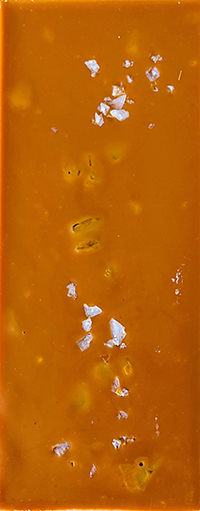
True to her promise, at the popup a few weeks later at Oaktown Spice Shop on Grand Avenue in Oakland, Julia had the Early Girl Summer bar. She had dehydrated the tomato skins and seeds, and added them to her vegan white chocolate mix along with some fennel pollen and seeds. Julia described the flavor as “capturing summer.”
The orange/pink bar smelled tomatoey with visible crunchy bits of salt flakes and what we learned was fennel pollen toffee. Julia told us that she added wild fennel pollen to add a balance to the bar’s sweetness. She made toffee from the pollen, cane sugar, and fennel seeds, and added the toffee pieces to the chocolate.
The results were a success; Julia described the bar has having an end of summer color and flavor. (Don’t call it pumpkin colored.) She said it would be good on a cheese plate with its sweet and sour with a little salt flavor profile.
I loved its pretty color and sweet/salty tomato taste. Tomato is a fruit after all. The wild fennel pollen added a savory note, and the bar had a slightly starchy texture like the Mylk chocolate bar. This bar was such a nice experience and the sweet/tart taste reminded me of rhubarb crisp.
This bar is a good example of Julia’s mission to upcycle food waste/rescue food. While she is still searching for a more appealing term, she said there is a lot of good left in upcycled food. Instead of throwing away the seeds and skins after processing tomato sauce as most people do, she was able to turn them into a tasty bar.
What she is doing with J Street Chocolate is more than reducing food waste, she is taking what would be discarded and making something amazing out of it. Kinda like the quilts of Gee’s Bend in Alabama: beautiful, colorful abstract looking comforters which southern Black women have been making for decades from old clothes and scraps of cloth. Practical and delightful — both the quilts and the chocolate.
Piv Snacks
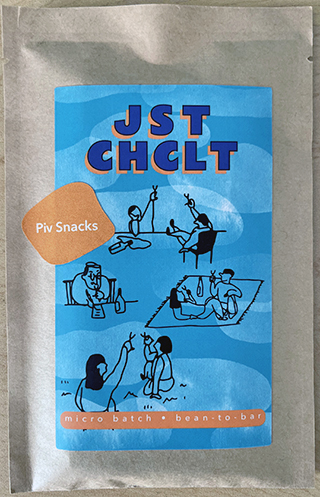
The 53% Piv Snacks bar was another bar made with Kokoa Kamili cacao. It used spent grain from Laughing Monk brewery in SF as an inclusion. Julia told us normally spent grain goes to feed pigs, but not in the city, so she can divert it to chocolate making. She said she dehydrates it which gives it a bready flavor that goes well with the bean. She also added crunchy pieces of Triscuit-esque crackers for texture.
The lower percentage gave it a soft snap. There were big flakes of Maldon sea salt sprinkled on the back, but they gave it only a slightly salty taste. It was a savory chocolate, which surprised me since it’s 53% cacao, and had a slight garlic/sriracha flavor (but not any heat).
I found this to be more of a chewing chocolate than a melting one. But as it melted (after some chewing) the chocolate had a tropical fruit flavor.

70% Rye Not?
The 70% Rye Not? used the same Camino Verde beans as the 72% Camino Verde Moromi and had the same strong fruity chocolate taste. This time, Julia added sourdough rye bread crumbs to the cacao, cocoa butter, and sea salt base.
I recommend letting this bar melt in your mouth first then start crunching to get the most flavor. The bar started with that good chocolatey flavor, and had lots of crunchy bits. The rye flavor came toward the end after chewing and was subtle.
Personally I would add more rye flavor — although I don’t know how because it had plenty of crunchy rye bread crumbs. I liked the sweet/savory combo — I’m a big fan of strawberry jam topped rye toast — and I think the chocolate could handle a more assertive rye. If you are rye-unsure, however, this might be the bar to try as the rye is definitely the under taste in this matchup.
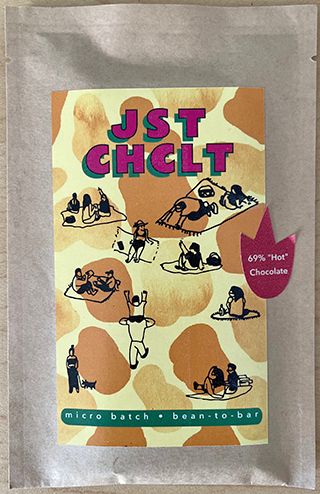
69% “Hot” Chocolate
The last J Street Chocolate bar we sampled was the 69% “Hot” Chocolate. It used the fruity Camino Verde cacao and a fermented jalapeño chili pepper paste.
The bar had a sharp snap, and as soon as it started melting, it was hot. It got hotter as it melted and was definitely hotter than the Some Like It Mild bar. The texture was slightly grainy. I thought the fermented pepper paste tasted a little like sriracha but fruitier. The pepper warmth lingered a long time.
Always something to look forward to
Because of the nature of J Street’s ingredient sourcing, not all bars are available at all times. In fact, some of the bars we tried were not available online after the popups. Other flavors that weren’t available at the popups that I look forward to are Miso Chocolate (which uses a miso Julia makes from cacao nibs), When the Beet Drops (which uses upcycled beets, raspberries, and pickled limes), Save Some for Sesame (toasted sesame and preserved Meyer lemons), and some plain single origin bars.
In addition to the established flavors, Julia is always working on new flavors. At the last popup she mentioned that she is currently experimented with the leftovers from nut milk processing. Sounds interesting.
When asked how she got to making chocolate with these types of inclusions, Julia explained that she started with fermenting sauerkraut, but “fermentation is a slippery slope. I love big projects, so fermentation is a good fit for me. There’s a multistage process to making koji, for example.”
She even did a fermentation residency, and before she started J Street, she worked at Preserved in Oakland, which sells all things related to preserved food from equipment and supplies to the actual products. They carry J Street Chocolate, of course. And J Street will offer a chocolate class next year there (another reason to sign up for the J Street newsletter if you’re interested).
While the business is only a year old, Julia started making chocolate several years ago which I think is one reason the bars are so good. It’s evident from tasting them that a lot has gone into their development. The bars hit all the notes for me: well made bars, good chocolate, and interesting inclusions that work well with the cacao chosen for the bars. To me all good chocolate balances the art and science of making it, and J Street Chocolate achieves that balance.
This experience has been fun, tasty, and educational — like a whole new food area to learn. J Street Chocolate’s chocolate is very creative, interesting, and tastes good too. As Cacaopod described it, it’s chocolate worth experiencing. Complex but easy to grasp, and each flavor is unique.
If you can find it, try it!

